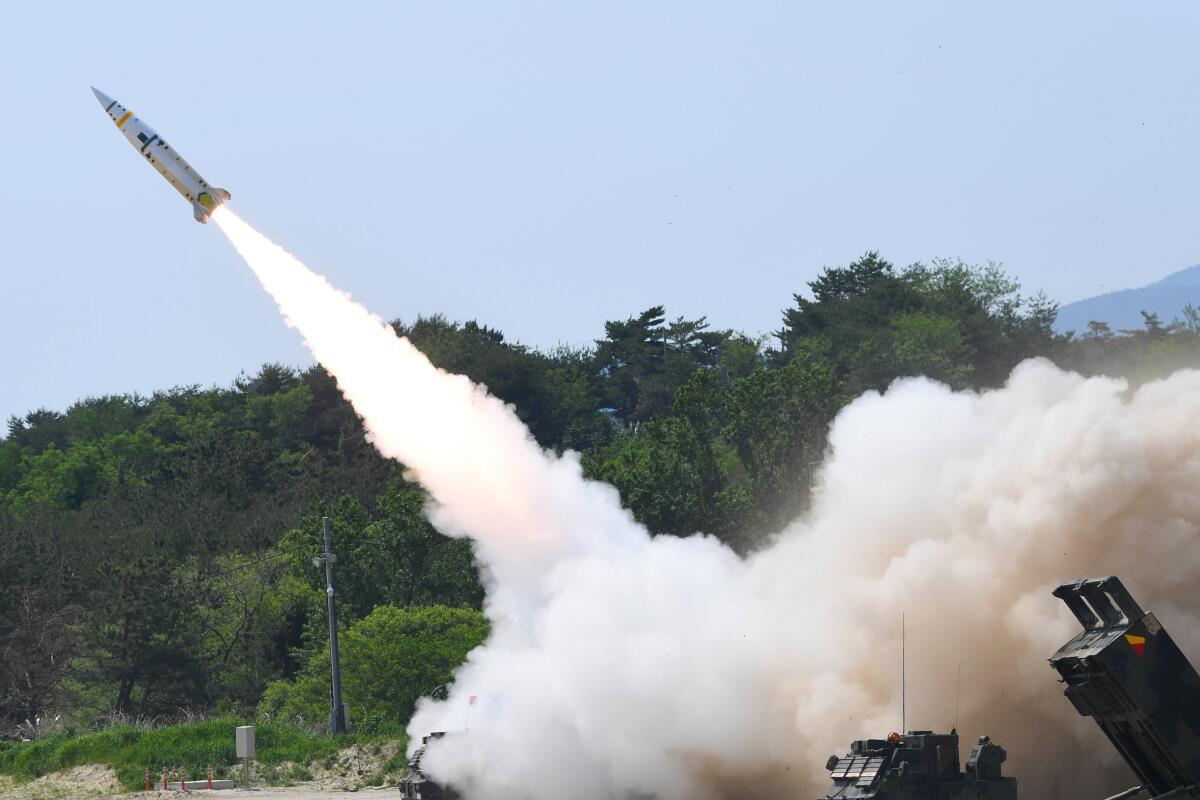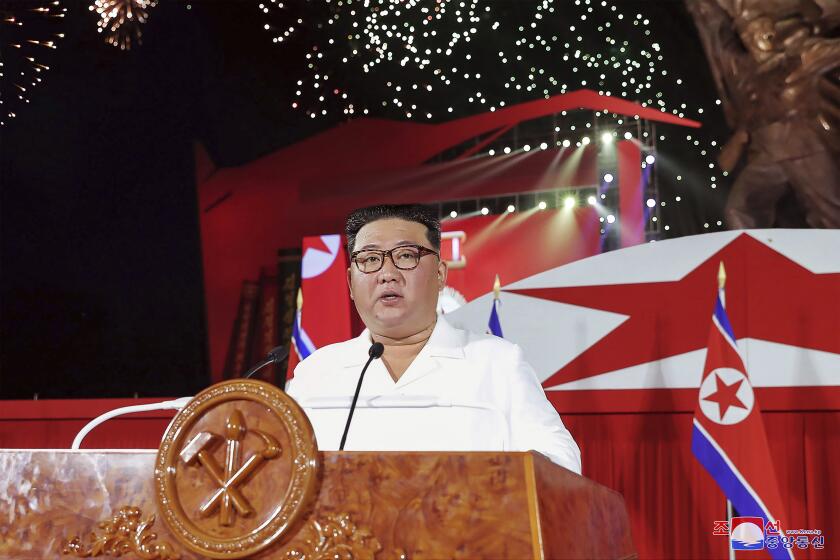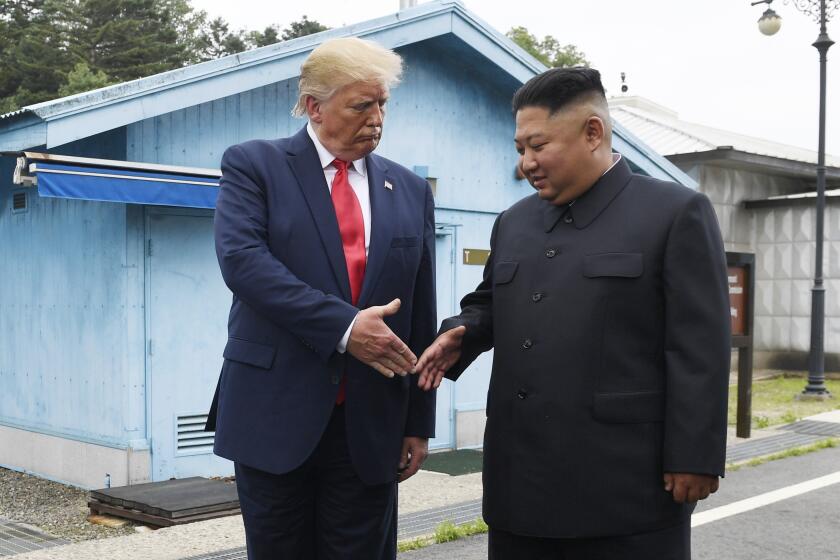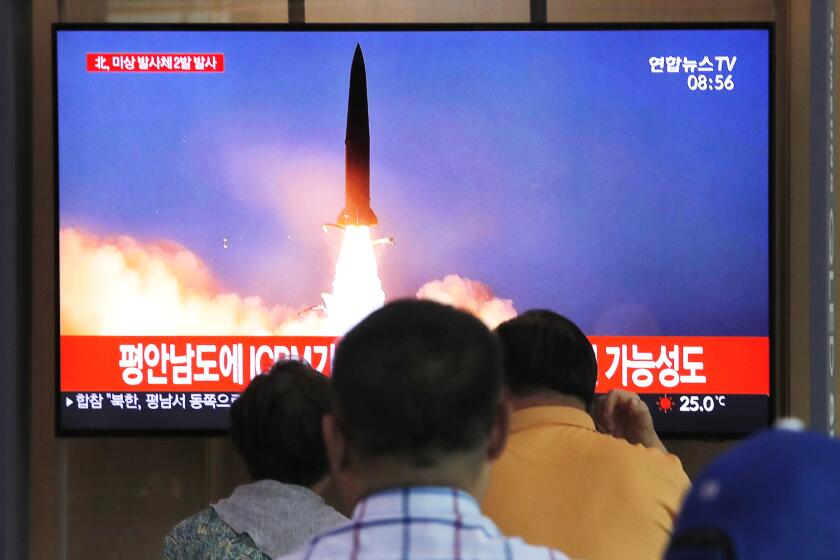U.S., South Korea to conduct expanded military drills amid North’s growing hostility

- Share via
SEOUL — The U.S. and South Korea will begin their biggest combined military training in years next week in the face of an increasingly aggressive North Korea, which has been ramping up weapons tests and threats of nuclear conflict against Seoul and Washington, the South’s military said Tuesday.
The allies’ summertime drills, which will take place from Aug. 22 to Sept. 1 in South Korea under the name of Ulchi Freedom Shield, will include field exercises involving aircraft, warships, tanks and potentially tens of thousands of troops.
The drills underscore Washington and Seoul’s commitment to restore large-scale training after they canceled some of their regular drills and downsized others to computer simulations in recent years to create space for diplomacy with Pyongyang and because of COVID-19 concerns.
The U.S. Department of Defense also said the U.S., South Korean and Japanese navies took part in missile warning and ballistic missile search-and-tracking exercises off the coast of Hawaii from Aug. 8-14, which it said was aimed at furthering trilateral cooperation in face of North Korean challenges.
While the U.S. and South Korea describe their exercises as defensive, Ulchi Freedom Shield will almost surely draw an angry reaction from North Korea, which describes all allied trainings as invasion rehearsals and has used them to justify its nuclear weapons and missiles development.
China, North Korea’s main ally, expressed concern over the expansion of U.S. military exercises with its Asian allies, saying they could worsen tensions with the North. Chinese Foreign Ministry spokesman Wang Wenbin didn’t offer a specific answer when asked whether Beijing believed the trilateral drills in Hawaii were in some way directed at China.
North Korean leader Kim Jong Un warned he’s ready to use his nuclear weapons in potential military conflicts with the United States and South Korea.
“North Korea has repeatedly expressed its concern” over the joint drills, Wang said in a briefing in Beijing on Tuesday.
“The negative impact of the military exercises on the situation on the Korean Peninsula is worth paying attention to. All parties should act prudently and stop any actions that may increase tension and confrontation and damage the mutual trust,” he said.
Before they were shelved or downsized, the U.S. and South Korea held major joint exercises every spring and summer in South Korea. The spring training had been highlighted by live-fire drills involving a broad range of land, air and sea assets and usually involved around 10,000 American and 200,000 Korean troops.
Tens of thousands of allied troops had participated in the summertime drills, which had mainly consisted of computer simulations to hone joint decision-making and planning, although South Korea’s military has emphasized the revival of large-scale field training this time.
Trump’s ‘fire and fury’ strategy didn’t work, but will Biden’s? Intelligence officials worry Kim is up to something, especially as Biden visits South Korea this week.
Officials at the South Korean Defense Ministry and its Joint Chiefs of Staff did not comment on the number of U.S. and South Korean troops that would be participating in Ulchi Freedom Guardian Shield.
The drills, which will kick off along with a four-day South Korean civil defense training program led by government employees, will reportedly include exercises simulating joint attacks, front-line reinforcements of arms and fuel, and removals of weapons of mass destruction.
The allies will also train for drone attacks and other new warfare developments shown during Russia’s war on Ukraine and practice joint military-civilian responses to attacks on seaports, airports and major industrial facilities like semiconductor factories.
“The biggest meaning of [Ulchi Freedom Shield] is that it normalizes the South Korea-U.S. combined exercises and field training, [contributing] to the rebuilding of the South Korea-U.S. alliance and the combined defense posture,” Moon Hong-sik, a Defense Ministry spokesperson, said during a briefing.
A nuclear conflict involving less than 3% of the world’s stockpiles could kill a third of the world’s population within two years, researchers say.
Some experts say North Korea may use the drills as an excuse to stir up tensions.
The North has already warned of a “deadly” retaliation against South Korea over its COVID-19 outbreak, which it dubiously claims was caused by anti-Pyongyang propaganda leaflets and other objects flown across the border by balloons launched by activists in the South. There are concerns that the North Korean threat, issued last week by the powerful sister of leader Kim Jong Un, portends a provocation, which may include a nuclear or major missile test or even border skirmishes.
Kim Jun-rak, spokesperson of South Korea’s Joint Chiefs of Staff, said the South Korean and U.S. militaries were maintaining a close watch on North Korean military activities and facilities.
Animosity has built up on the Korean Peninsula since U.S.-North Korea nuclear negotiations derailed in early 2019 over lifting crippling U.S.-led sanctions in exchange for the North’s disarmament steps.
News Alerts
Get breaking news, investigations, analysis and more signature journalism from the Los Angeles Times in your inbox.
You may occasionally receive promotional content from the Los Angeles Times.
Kim Jong Un has since declared that North Korea would bolster its nuclear deterrent in the face of “gangster-like” U.S. pressure, and halted all cooperation with the South. Exploiting a division in the United Nations Security Council over Russia’s war on Ukraine, North Korea has dialed up weapons testing to a record pace this year, conducting more than 30 ballistic launches. They have included the country’s first demonstrations of intercontinental ballistic missile technology since 2017 and further tests of tactical systems designed to be armed with small battlefield nukes.
Kim has punctuated his testing binge with repeated warnings that the North would proactively use its nuclear weapons in conflicts with South Korea and the United States, which experts say indicate an escalatory nuclear doctrine that could cause greater concerns for its neighbors.
More to Read
Sign up for Essential California
The most important California stories and recommendations in your inbox every morning.
You may occasionally receive promotional content from the Los Angeles Times.













